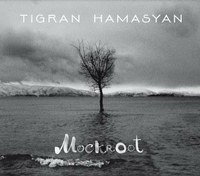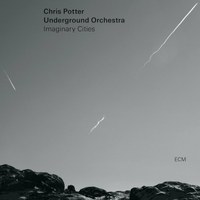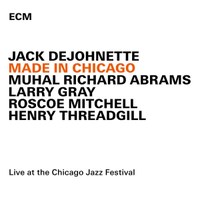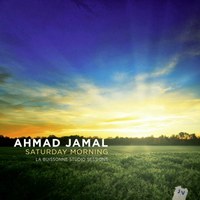19.4.2015
| Kedy |
19. 04. 2015 od 19:00 do 22:00 |
|---|---|
| Kde | klub |
| Vstupné |
za členské a 2% |
| Autor | GabrielKo |
OMAR SOSA, TIGRAN HAMASYAN 
OMAR SOSA : ILÉ
Cuban-born pianist and composer Omar Sosahas carved out a place for himself in the musical landscape that's equal parts musical and spiritual. His playing and his songs are saturated with the beauty and power of West African music dedicated to Yoruba deities, and yet an unmistakable reverence for jazz pervades every note.
Sosa's latest album, Ile, doesn't disappoint. The title is the Lucumí word for "home," and it accurately reflects a homecoming of sorts, back to the kind of straight-ahead Afro-Cuban jazz that he started out playing. The album features the core of the working group with which he travels the world, his Quarteto Afro Cubano.
Yet even when he goes home, Sosa brings along the influences he's picked up during his travels: The songs sway from clever, clave-based Latin jazz to Lucumí chants to short interludes with distinct down-tempo grooves.
When he performs live, Sosa makes a point to prepare the stage and his space for any spiritual visitations that might take place in him or the audience. It's far from a cheesy, halfhearted nod to ancient gods. Ask anyone who's been to one of his shows: If the spirits speak to anyone, it's Omar Sosa.
TIGRAN HAMASYAN : MOCKROOT
 Tigran Hamasyan’s Nonesuch Records debut album, Mockroot, was released in February 2015. Tigran’s music draws from a wide range of sources—from jazz and Armenian folk music; Bach and French fin de siècle composers; dubstep, thrash metal, and contemporary electronica. His live performances and six studio albums have received enthusiastic approval from the likes of Herbie Hancock, Chick Corea, and Brad Mehldau.
Tigran Hamasyan’s Nonesuch Records debut album, Mockroot, was released in February 2015. Tigran’s music draws from a wide range of sources—from jazz and Armenian folk music; Bach and French fin de siècle composers; dubstep, thrash metal, and contemporary electronica. His live performances and six studio albums have received enthusiastic approval from the likes of Herbie Hancock, Chick Corea, and Brad Mehldau.
Where his last album, 2013’s Shadow Theatre, featured an extended band with choral sections, strings, and saxes, Mockroot is based around the tight trio of Tigran on piano and vocals, Sam Minaie on bass guitar, and Arthur Hnatek on drums.
"For me it’s more like an electro-acoustic Armenian rock trio than a regular jazz trio," says Tigran. "Sometimes we sound like a heavy metal band, or a dubstep DJ, or like some late 19th century Armenian composers like Nikoghayos Tigranyan and Komitas, with newer harmonic and rhythmic approaches. It’s all underlined by something that’s very simple, melancholic, and romantic."
The album title, Mockroot, touches on a theme that suffuses the album—one of the natural world always triumphing over human complexity. "It is inspired by the photograph on the album cover," he says, "a picture my friend Karen Mirzoyan took of a tree—almost dead—emerging from a lake. It was taken in a part of the world where people had deliberately raised the water level to irrigate land. And yet this tree just carried on, defiantly. It’s the idea that nature is constantly mocking humanity. Whatever we impose upon it, nature will always win. Technology has taken us into crazy areas, but we need a core of humanity to make sense of the world.
"To me this album is kind of sad and melancholic. Even the brainier or more math-oriented songs have a sort of romanticism and longing in them. The songs represent a critique of our world and humans as they are now, which is more materialistic and less spiritual, less humble and thankful, more ignorant and egotistically ‘happy,’ a lot of knowledge, but about what values? People are loving, but we love money and ourselves; we are technologically more advanced and ready to ignore love in the name of ‘progress,’ healthier and stronger, more scared and faithless. There are more tractors cultivating the soil and fewer folk songs being cultivated; there are more churches than there are people who still remember how to pray.
"Mockroot is a sort of longing and nostalgia for a human nature that’s more spiritual, more loving, more together with its roots. There is a sacrifice in it—sacrifice to try to elevate spiritually."
Tigran Hamasyan was born in 1987 in Gyumri, near Armenia’s border with Turkey. Neither of his parents were musicians (his father was a jeweller, his mother a clothing designer), and Tigran grew up listening to his father’s heavy rock collection (Led Zeppelin, Black Sabbath, Deep Purple, Queen, Nazareth). By the age of three, he was picking out pop melodies on the family piano and being sent to piano lessons; from the age of six he was attending a specialist music conservatory. By 11 he was a classical virtuoso who also sang jazz standards and Beatles tunes with a big band; by 13 he was experimenting with Armenian folk music. At 16, after winning the Montreux Jazz Festival’s piano competition, he relocated with his family to Los Angeles, where he released his debut album, World Passion, at the age of 18.
For more than a decade, Tigran Hamasyan has been part of California’s sizeable Armenian-American community, but he has spent much of the last year living in the Armenian capital, Yerevan, with his grandmother. "In April I went to Armenia to teach some master classes for a month. It rekindled a yearning I’ve had for many years to return, and I found some great stuff while I was there. It was very inspiring."
Armenia looms large throughout Mockroot. The opening track, "To Love," and "To Negate" are both inspired by the Armenian poet Petros Duryan. "Lilac" is about a tree that stood in the backyard of Tigran’s childhood home; "Song for Melan and Rafik" is dedicated to his grandparents; "The Apple Orchard in Saghmosavanq" is a romantic song about a monastery near Yerevan. "Kars 1" and "Kars 2 (Wounds of the Centuries)" are written about the town of Kars, the ancestral home of Tigran’s maternal grandparents, a place that became part of Turkey in the years that followed the infamous Ottoman genocide of Armenians during the First World War.
Although the subject matter has implicitly political overtones, Tigran avoids making these explicit. "I try not to get sidetracked by politics," he says. "Some people are more interested in using music as a platform for politics. I want to be a musician, not a politician. For me, it’s more personal.
"Armenian folk songs are sometimes political whether you like it or not—especially given the fact that 90 per cent of Armenian folk music and culture comes from a part of the country that is now in Turkey. That culture is still alive, thanks to the great-grandpas and -grandmas that kept and transferred their songs and dances to the younger generation after migrating from old Armenian cities like Van, Mush, Karin (Erzurum) and Sasun to what is now eastern Armenia. So, for me, it’s about learning what they have kept for me and about stories that arise from that situation."
Many of the tracks are inspired by poetry, in particular the flowering of Armenian and Russian verse of the late 19th and early 20th century. "I’ve always read a lot of poetry, ever since I was a teenager," he says. "I’d listen to Jan Garbarek or Keith Jarrett for hours, and then immerse myself in Armenian poetry. It will inspire specific feelings. Occasionally I will play the piano while reading a poem, accompanying the words, but usually I will try and recreate the feelings inspired by a certain poems while improvising at the piano." Several of these poems are printed in full as part of the album sleeve notes. However, despite this congruence between words and music, most of Tigran’s songs are wordless.
"When playing melodies inspired by Armenian folk songs, I sometimes try singing English language lyrics, but English sounds off-putting and unnatural and weird in the songs, while Armenian lyrics sound too direct. Lyrics can be magical, but they can often direct you to a certain place that is quite different from where the music is taking you. By singing wordlessly, you’re not obliging the audience to think about a certain thing—it can be about anything. You are relinquishing ownership to the audience, which is exciting."
—John Lewis
John writes about music for the Guardian, Uncut and Metro.
 Chris Potter Underground Orchestra : Imaginary Cities
Chris Potter Underground Orchestra : Imaginary Cities
As the billing on the cover indicates, Chris Potter extends the creative envelope of his longstandingUnderground Orchestra on his second date as a leader for ECM. Guitarist Adam Rogers, drummer Nate Smith, and pianist Craig Taborn all return. The additional architecture includes not one but two bassists inScott Colley (acoustic) and Fima Ephron (electric). Steve Nelson (Potter's former bandmate in Dave Holland's quintet) plays marimba and vibes, and a string quartet -- violinists Mark Feldman and Joyce Hammann, violist Lois Martin, and cellist David Eggar -- make this the "Underground Orchestra." "Lament" is introduced by the string quartet playing a near-Baroque melody before the jazz group enters with Rogers' warm, electric guitar. Potter's first solo is moody as Nelson's vibes move toward modal terrain. Colley's bridge-like solo is woody and rich. Midway through, tempo and intensity shift, signified byTaborn and Smith. Potter flies on tenor and the rest of the orchestra ups the tension and pulse in support before exiting on a pastoral theme. The next 34 minutes are the four-part title suite. While its sections tend to offer formal melodies and harmonics that are painstakingly charted over various jazz and classical languages, there is plenty of room for the players to stretch out. "Pt. 1: Compassion" commences with the strings in a droning Eastern mode before a shadowy melody emerges. By the time Rogers delivers his stinging yet tasteful solo, it becomes a grooving electric jazz workout. "Pt. 2: Dualities" commences with a sprightly pizzicato string groove. Potter takes the melody, then rips it up in a squalling solo, even as the strings -- now bowing -- foreshadow his harmonic movement. By contrast, Nelson's solo is pure post-bop with excellent support from the rhythm section. Taborn's spidery pointillistic inquiries introduce "Pt. 3: Disintegration," but it's the string quartet that shines, offering abstraction as a backbone for Potter andRogers to emerge with an almost lush lyricism. The final section, "Rebuilding," is a striking piece of grooved-out creative jazz. Smith, Colley, and Ephron lock on as Taborn and Potter engage in muscular interplay. Rogers' solo is the highlight, creating a bridge between parts as the strings offer not only color but harmonic direction. Remarkably, there are three more pieces here, including the knotty, funky "Firefly," withRogers offering as much textural flavor as a B-3 organ. Closer "Sky" has a lush cinematic melody. It's an excellent showcase for Potter, Taborn, and the string quartet, who all deliver excellent solos while keeping the tune's large landscape feel throughout -- one can hear traces of Aaron Copeland in some of its thematic lines. Potter's writing on Imaginary Cities engages every aspect of his jazz palette. It embraces modern classical music as part of a striking whole. It is his most ambitious project to date, and arguably his most expertly articulated.
 Jack DeJohnette : Made In Chicago
Jack DeJohnette : Made In Chicago
In 2013, the Chicago Jazz Festival invited Jack DeJohnette to assemble a dream band to open. The renowned drummer, composer, and pianist assembled a group whose personnel revisited the roots of his early days on the city's South Side: saxophonist Roscoe Mitchell and saxophonist/flutist Henry Threadgill-- with whom he had attended Wilson Junior College in the early '60s -- and mentor Muhal Richard Abrams, whose Experimental Band they all played in. Abrams also co-founded the historic Association of Creative Musicians (AACM) that fostered the talent of all three, and a bit later, this group's bassist Larry Gray. Reunions can be a tricky business in the jazz world, especially when people haven't played together in nearly five decades. That said, this set works far more often than it doesn't, and it never really falters. There is ample chemistry between the principals. Mitchell's "Chant" gets things off to a lively start. Its melody is short and repetitive, with a children's song quality expressed by the saxophones. Abrams plays off the top, engaging in counterpoint, and DeJohnette rolls it out, filling, accenting, and pushing; he's followed by Gray as the dialogue between the horns commences and solos appear within it. That notion of repetition also fuels DeJohnette's "Museum of Time," where Abrams plays a glissando pattern in a compact mode as the horns respond with short, blues-like phrases as the composer whispers and rushes along on brushed cymbals. Gradually, the work opens up with a brief and lovely Abrams solo, as the horns, in slightly staggered phrasing, capture the mournful melody before they begin to moan it out. Gray's andDeJohnette's tom-toms eventually add a funky backdrop to Abrams' second solo and a dialogue between flute and saxophone before the tune builds again with tension and drama. Threadgill's "Leave Don't Go Away" is simultaneously tight and sprawling. The saxophonist's collage ideas run rampant before Abramsdialogues intensely with the drummer and the bassist. Throughout Made in Chicago, ideas assert themselves, though they are occasionally ponderous and speculative as in Abrams' "Jack Five" andMitchell's chamber jazz piece "This." Even in these, however, there are nearly sublime moments thanks toGray -- his earthy solo in the former tune and his fluid arco playing in the latter keep things from going too far afield. The last piece here, "Ten Minutes," is a strident, thoroughly engaging, even bracing group improvisation with wonderful conversation, sparkling ideas, and soloing. While Made in Chicago was supposed to be a one off, it turns out to have been a lift-off point for further concert engagements. This document is important not only for the historic nature of the reunion of vanguard jazz luminaries, but as the spark for further exploration.
 Ahmad Jamal : Saturday Morning
Ahmad Jamal : Saturday Morning
Just over a year after Blue Moon (Jazzbook Records, 2012) —Jamal's stellar homage to American cinema and Broadway—the Pittsburgh pianist returns in the same rich vein of form onSaturday Morning. Blue Moon earned a Grammy nomination, and for the second time in recent years Jamal was invited to open the Lincoln Center season in September; clearly, Jamal is enjoying his status as one of jazz's great, elder statesmen. Saturday Morningcould almost be part of the same sessions that produced Blue Moon with its mixture of standards, new compositions and reworked older material. LikeBlue Moon, this recording occasionally evokes his classic 1950s Argo years, only there's more meat on Jamal's arrangements these days, and remarkably, greater fire in his fingers.
Though drummer Herlin Riley and former Weather Report percussionist Manolo Badrena first played with Jamal in the 1980s, these latter two Jamal recordings have the feel of a new quartet, especially in the wake of the departure of long-standing drummer Idris Muhammadand bassist James Cammack. Happily, bassist Reginald Veal is much more prominent than on Blue Moon, engendering real swing and irresistible funk grooves. Stepping into Cammack's shoes—Jamal's bassist for 29 years—can't have been easy but Veal's lyricism, bold motifs and striking improvisations color the music greatly. Badrena conversely, plies his wares more subtly than before, while Riley keeps a simple, in the pocket groove throughout, rarely slipping the leash.
Jamal has created his own language on piano; on "Back to the Future" his jangling left-hand powers like rising flood water while rhapsodic right-hand explorations alternate between chordal steps, spinning flurries and long, cascading runs. On this opening number Jamal's two-handed synchronized run towards the finishing line and his trademark final punctuation epitomizes the sense of drama that inhabits his play. On "I'll always be with You" Jamal emerges from a tempestuous improvisation to land on the most delicate of blue notes, as though flung from a washing machine only to land on his feet immaculately attired.
Jamal admirers and detractors alike point to his continual, restless motivic development and compositions like the gently paced "Edith's Cake" and the grooving "The Line" have enough "fiddling and diddling"—to quote Cammack from a 2012 interview—to delight and frustrate according to taste. At his most fluid, when there don't seem to be enough keys on the piano to accommodate his dazzling runs, it's easy to see where pianist Hiromi Uehara finds much of her inspiration.
For all his technical dexterity and passion, Jamal is never more at home than when caressing and teasing the melody of a ballad. There are a few to savor here, notably a majestic rendition of "I'm In the Mood for Love" and Duke Ellington's "I Got it Bad and that Ain't Good." On the latter, Jamal plays with the melody, letting it drift before gently rekindling the flame. Bass, brushes and percussion lend tender support. Jamal can't resist quoting the melody to "Take The A-Train" here, and on numerous occasions throughout the album he exercises his penchant for quoting the popular melodies he has breathed for a lifetime.
Jamal pays tribute to pianist Horace Silver on the Afro-Caribean flavored "Silver," whose simple melody and uncluttered arrangement harks back to the Jamal of yesteryear. Similarly, the sparse architecture and beautiful minimalism of Saturday Morning recall At The Pershing:But Not For Me (Argo, 1958)—a million-selling album that cemented Jamal's reputation as an original and influential voice. The lilting melody of the title track is hypnotic enough for the quartet to repeat it throughout the song's ten-minute duration without it ever sounding less than charming —a signature tune to replace "Poinciana" perhaps?
The title track from One (20th Century Fox Records, 1978) seems like an unnecessary indulgence on an album that weighs in at a healthy one hour. Nevertheless, its jaunty melody and infectious groove will appeal to new fans and maybe send others back to rediscover an overlooked recording nestled in the middle ground of a discography that dates to 1951. "Saturday Morning (reprise)"—a three and a half-minute radio-friendly version—serves up that delightful melody one last time and burns it into the subconscious mind—if it wasn't already there.
Jamal proves once again that he's lost none of his customary elegance or electricity. His expansive imagination as an interpreter of standards—particularly ballads—remains almost unmatched. The four musicians sound fully molded to each other contours and the result is music that is fantastically tight yet exhilarating. Jamal is still minting great melodies, still blazing his own trail and—for many—still leading the way.
